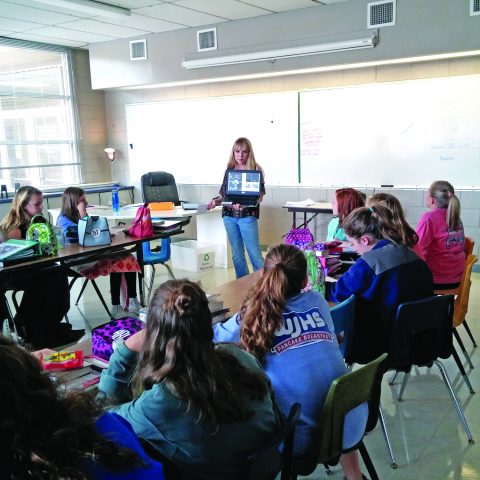Many freshmen walk into high school on the first day without that one class, teacher or group that provides a sense of belonging.
Besides creating an amazing yearbook our school can be proud of, my goal as a yearbook adviser has always been to give my students a place to belong in junior high. Another goal of mine has been for them to continue in our journalism program at the high school level, which might make for a less-awkward first day.
There are two activities I do every year to encourage my students at Woodland Junior High School in Fayetteville, Arkansas, to extend their journalism training into the ninth through 12th grades.
Go for a visit.
The first activity is our visit to the high school to tour the journalism opportunities available there. We go in the spring before the students choose their classes for the next year.
Every year, we take a bus from our junior high to the high school. When we arrive, we meet with our tour guide – usually one of my former yearbook staffers – who explains a little about the specific journalism courses they are taking.
At this point, my staff has general questions about high school ready and we use this introductory time for our tour guide to answer those questions. Then we begin our tour.
We visit newspaper, Connotations (the literary magazine), yearbook, television and film. With each stop, the adviser explains what the staff does and allows my staff to see them actually working on something.
In the past, we have seen sample news programs they have produced, the editorial circle discussion for the national award-winning literary magazine, and the yearbook staff working on their book. The staffs are always prepared to answer any questions my students may have.
This trip calms the nerves of my staff about high school and gives them an “inside look” at how they can use what they have already learned in yearbook at the next level.
The adviser at Fayetteville High School, Stephen Teague, agreed this trip is beneficial for them. He said these activities “provide a little more of a comfort level for incoming new students.
“I think when they come in and see the high school students working on things in a very similar fashion as they do in junior high, it’s less intimidating. It helps that they get to see future classmates and a possible future teacher.”
Have them come to you.
I also have students from the high school come visit us and train my students on an element for yearbook.
This has worked wonders for my staffs every year. Advisers can explain things until we are blue in the face, and some staffers will still struggle or have glazed eyes. However, when you have a high school student saying the same thing, in maybe a different way or tone, the younger students listen intently.
This is valuable for the staff because they see what journalism requires of them at the high school level and they are ready for that next step.
“I’ve always appreciated the fact that they’ve gone through the fires of deadlines, staff discord (and) stress and know that yearbook has to be a priority for the book to be a success,” Teague said.
I always have a high school staffer come and talk about photography, and I have a staffer discuss another yearbook topic that students may need help with.
Photography
Everyone on my junior high staff takes photos. Since they all take photos, it is important to have good camera and photography training for the whole staff.
After I have given instructions on basic photography and they are wrestling with settings, angles and location, I bring in a high school yearbook staffer who used to be on my junior high staff. This allows my current staff to see someone who was in their shoes not long ago and has continued in journalism.
This year, the high school staffer brought photos she had taken and explained how she had taken each one, from settings to where she stood. She also explained photo lingo such as ISO, aperture and white balance, which, combined with what I had already taught them, really helped them with their photography.
Photoshop
This year we were doing something special with our folio that was going to require many student cutouts. I am not a whiz at Photoshop, but I can get by. I wanted my staff to see the easiest and most effective uses of Photoshop, so I invited a former staffer who is great with Photoshop to come in.
She showed them how to lighten and darken photos, how to remove certain colors from a photo such as the yellow in photos taken in the gym, and two ways of cutting out backgrounds from a photo. Within two days, every member of my staff had COBed at least three photos!
While it is usual for high school students to visit colleges, my students have gained so much from visits to their next school and their exchanges with high school journalism students.





